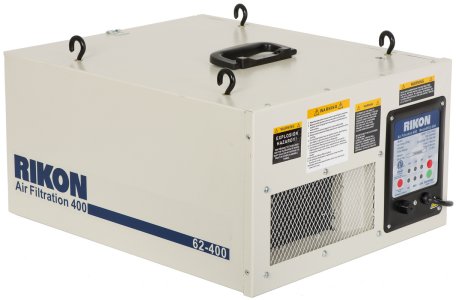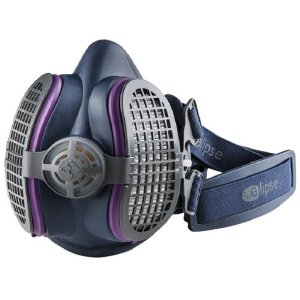|
Dear Wood News,
The U.S. Department of Labor Office of Safety and Health Administration (OSHA) has determined that exposure
to airborne wood dust from Western Red Cedar in excess of 2.5 mg per cubic meter of air and to dust from
any other woods in excess of 5 mg per cubic meter is hazardous to your health, and has ruled that General
Industry must keep exposure in the workplace below these limits.
It's interesting to note that OSHA considers wood dust exposure more hazardous than exposure to Chloroform
whose mg per cubic meter limit is 9.78; or Carbon Monoxide at 40; or Turpentine at 560; or VM&P Naptha at 1350; or
Acetone at 1800.
There is no requirement that hobbyists comply with these limits in their home shops, but it would benefit
their own safety and that of others in the home, especially kids.
I would be interested to know, and I think your readers would also, how much airborne wood dust is 5 mg per
cubic meter?
Sincerely,
R.S.L.
We're not exactly ready to rush out to the workshop laboratory and measure out a government-approved five
milligrams of wood dust, but we can illuminate the subject at least dimly as follows: 5 mg equals less than
two ten-thousandths of an ounce. According to OSHA standards, a moderate-size woodworking shop, 15 by 30
feet with ten-foot ceiling, will reach the permissible exposure limit (PEL) when there are two hundredths
of an ounce of wood dust in the air. Egad, Pogo, that's not much dust! (A dime weighs eight hundredths
of an ounce.) If anyone happens to know any intelligible details on this subject, such as how OSHA defines
dust, how visible dust is at 5 mg/cubic meter, and can you even turn on a sander or a planer or a router
without going over the PEL, please let us know.
These standards might sound absurdly strict and downright unrealistic, but they do make one fact quite clear:
the people charged with keeping workers safe in the workplace think that wood dust is very bad for you.
Most of us won't have any trouble agreeing with that, having experienced plenty of clogged lungs, wood-toned
sinuses, bleary eyes, sore throats, allergies and other assorted ailments traceable to breathing in the
average shop. We also know that a dusty shop is indirectly hazardous to the occupants' well-being; though most
us don't even want to be conscious of it, the direct health effects together with the physical inconvenience
of a dirty shop add a constant background of stress to an activity that doesn't need that at all, for the
hobbyist or professional alike.
Dust Collection
Almost every shop could do a whole lot more to reduce the amount of dust allowed to get into the air. Some tools,
like most hand-held routers for instance, present really difficult dust control problems because it can be
nearly impossible to collect very much of the waste at the source; once dust gets into the air, only powerful
whole-shop filtered circulation or exhaust can relieve the problem. Many tools, though, allow the user
to hook up a dust collector or shop vac right at the source and eliminate most of it immediately, and more and
more tools are coming equipped for efficient dust collection.
Sooner or later a good dust collection system becomes an inescapable necessity in the well-equipped shop.
A lot can be accomplished with a good shop vac and a little ingenuity, but the vac reaches its limits when
dust is accompanied by huge quantities of solid waste, such as comes from a thickness planer, or when the
dust source area is greater than a few square inches, such as under an open-stand tablesaw or jointer.
Highland Woodworking is proud to sell the finest shop vacs available today,
Festool Dust Extractors.

Filtered-Fan Air Cleaner
Even a shop with vacuum ports on every tool and a dust collector in fulltime operation is still going
to run well over OSHA's guidelines in many situations. It's a good idea to have a simple filtered-fan arrangement
set up to routinely clean all the air in the shop. Running at low speed so as not to unduly stir up dust that's
already settled out, an inexpensive window fan moving air through a couple of furnace filters will gradually and
effectively remove very fine dust which would otherwise remain suspended for long periods.
Readymade solutions are also available, including our
Rikon 62-400 Air Filtration System.

Dust Mask
Finally, anyone who works wood with any tool more aggressive than a whittling knife needs a good dust mask,
and should automatically put it on whenever a machine is in operation, and keep it on until there's no dust
left in the air (or at least less than 2 ten-thousandths of an ounce per cubic meter).
Lots of folks think
dust masks are a nuisance, but would you really rather have bronchitis, or dust pneumonia, or hypersensitivity
to rosewood or some other shop horror? Inexpensive one-strap paper masks don't seal well enough to offer
good protection in the shop, but heavier and costlier two-strap disposables work quite well. The only drawbacks
to these masks are replacement cost and non-selective breathing -- that is, you breathe out as well as in
through the filter medium. When you're working hard and breathing hard, water vapor in your breath dampens the
mask, causing it to lose its shape, load with dust and become hard to breathe through.
Inexpensive plastic masks
with replaceable filters may be a good choice if you find one that happens to fit your face and seal well; sometimes
you can improve the fit with a bit of stick-on weatherstrip or other custom alteration. Using a paint-spray
respirator with the chemical cartridges removed isn't all that great an alternative because the masks are hot,
bulky and not especially easy to breathe through. Their under-the-chin wraparound design also makes it harder
for them to seal well over beards.
Thus we're pleased to introduce the best all-around mask we know of, the Elipse P100. This mask sits lightly
on the face (total weight is under 5 ounces), seals well even over beards (though its 99.97% effective rating
applies only to those whose faces are clean-shaven), and provides easy breathing for longterm comfort. Two adjustable
elastic straps let the user ensure a good fit with minimal pressure on the head and face. Simple one-way valves
direct exhalation through a port in the bottom of the mask, which keeps the filter dry and helps to avoid fogging
your eyeglasses. The gasket material is made from a non-allergenic thermoplastic elastomer that is latex and
silicone free.

This is an updated version of an article written by Zach Etheridge that appeared years ago in a print version
of our Wood News customer newsletter.
|